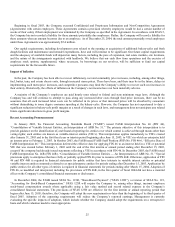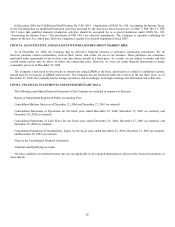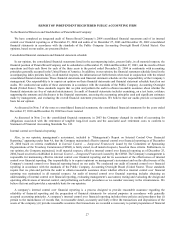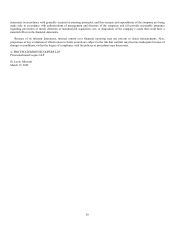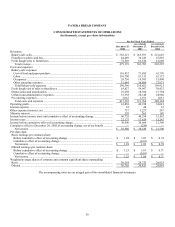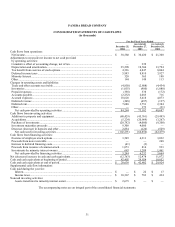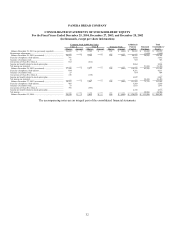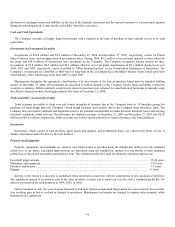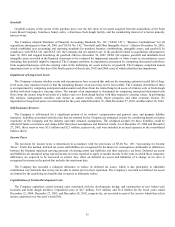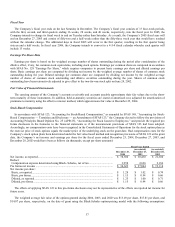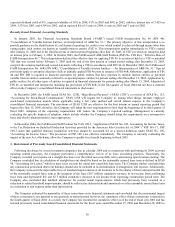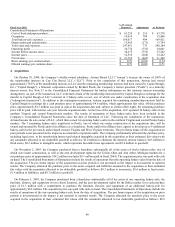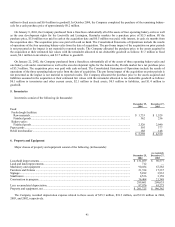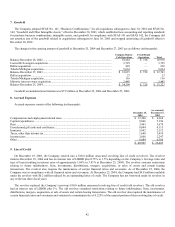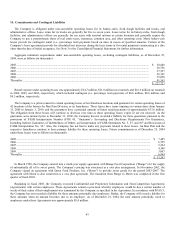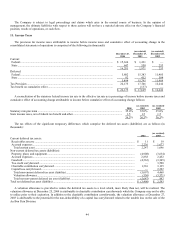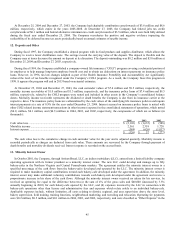Panera Bread 2004 Annual Report Download - page 41
Download and view the complete annual report
Please find page 41 of the 2004 Panera Bread annual report below. You can navigate through the pages in the report by either clicking on the pages listed below, or by using the keyword search tool below to find specific information within the annual report.Goodwill
Goodwill consists of the excess of the purchase price over the fair value of net assets acquired from the acquisitions of the Saint
Louis Bread Company, franchisee bakery-cafes, a franchisee fresh dough facility, and the membership interest of a former minority
interest owner.
The Company adopted Statement of Financial Accounting Standards No. 141 (“SFAS 141”), “Business Combinations” for all
acquisitions subsequent to June 30, 2001 and “SFAS No. 142, “Goodwill and Other Intangible Assets,” effective December 30, 2001,
which established new accounting and reporting standards for purchase business combinations, intangible assets, and goodwill. In
compliance with SFAS 141 and SFAS 142, the Company did not amortize any of the goodwill related to acquisitions subsequent to
June 30, 2001 and stopped amortizing all goodwill effective December 30, 2001. SFAS 142 requires goodwill and indefinite-lived
intangible assets recorded in the financial statements to be evaluated for impairment annually or when events or circumstances occur
indicating that goodwill might be impaired. The Company performs its impairment assessment by comparing discounted cash flows
from acquired businesses with the carrying value of the underlying net assets inclusive of goodwill. The Company completed annual
impairment tests as of the first day of the fourth quarter of fiscal years 2003 and 2004, none of which identified any impairment.
Impairment of Long-Lived Assets
The Company evaluates whether events and circumstances have occurred that indicate the remaining estimated useful life of long-
lived assets may warrant revision or that the remaining balance of an asset may not be recoverable. The Company determines if there
is an impairment by comparing anticipated undiscounted cash flows from the related long-lived assets of a bakery-cafe or fresh dough
facility with their respective carrying values. The amount of an impairment is determined by comparing anticipated discounted cash
flows from the related long-lived assets of a bakery-cafe or a fresh dough facility with their respective carrying values. In performing
this analysis, management considers such factors as current results, trends, future prospects, and other economic factors. No
impairment of long-lived assets was determined for the years ended December 25, 2004, December 27, 2003, and December 28, 2002.
Self-Insurance Reserves
The Company is self-insured for a significant portion of its workers’ compensation and general, auto, and property liability
insurance. Liabilities associated with the risks that are retained by the Company are estimated, in part, by considering historical claims
experience of the Company and the industry and other actuarial assumptions. The estimated accruals for these liabilities could be
affected if future occurrences and claims differ from these assumptions and historical trends. As of December 25, 2004 and December
27, 2003, these reserves were $3.5 million and $2.1 million, respectively, and were included in accrued expenses in the consolidated
balance sheets.
Income Taxes
The provision for income taxes is determined in accordance with the provisions of SFAS No. 109, “Accounting for Income
Taxes.” Under this method, deferred tax assets and liabilities are recognized for the future tax consequences attributable to differences
between the financial statement carrying amounts of existing assets and liabilities and their respective tax basis. Deferred tax assets
and liabilities are measured using enacted income tax rates expected to apply to taxable income in the years in which those temporary
differences are expected to be recovered or settled. Any effect on deferred tax assets and liabilities of a change in tax rates is
recognized in income in the period that includes the enactment date.
The Company has recorded a valuation allowance to reduce its deferred tax assets, which is due principally to charitable
contribution carryforwards that it may not be able to utilize prior to their expiration. The Company’s recorded net deferred tax assets
are limited by the underlying tax benefits that it expects to ultimately realize.
Capitalization of Certain Development Costs
The Company capitalizes certain internal costs associated with the development, design, and construction of new bakery-cafe
locations and fresh dough facilities. Capitalized costs of $4.7 million, $1.9 million, and $1.4 million for the fiscal years ended
December 25, 2004, December 27, 2003, and December 28, 2002, respectively, are recorded as part of the asset to which they relate
and are amortized over the asset’s useful life.
35


